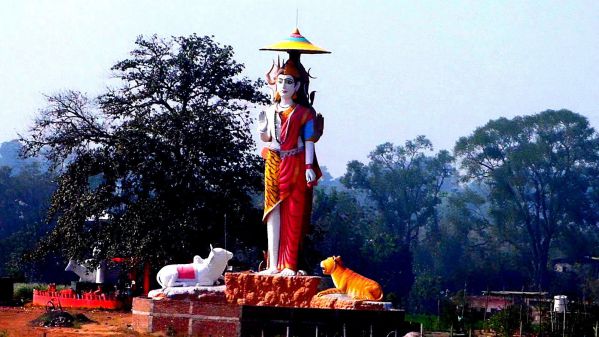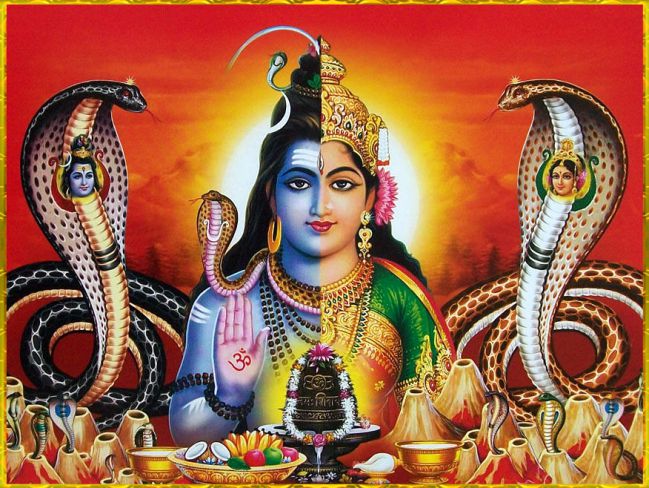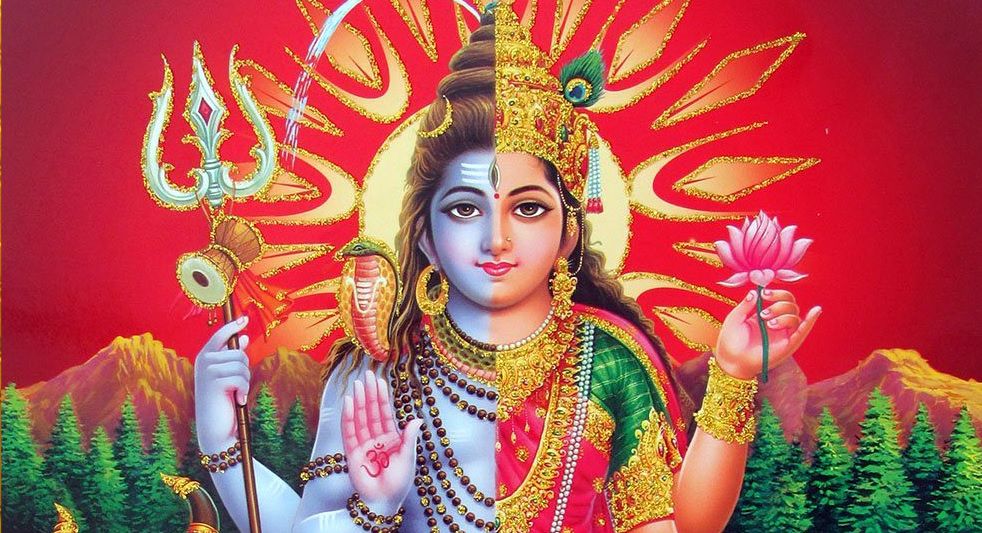No products in the cart.
Ardhanarishvara is a composite androgynous form of Shiva and his consort Parvati. This form is shown as a fusion of half-male and half-female forms, split down in the center. The right half is depicted as Shiva, while the left half shows the female form of Parvati.
The very name Ardhanarishvara implies “the Lord who is half-woman”. This form of Shiva is also referred to as Ardhanarisha, Ardhanarinateshwara, Ardhayuvateeshwara, Ardhagaureeshwara, Gaureeshwara, Naranaari, Parangada and Ammiappan.
Since Ardhanarishvara represents the perfect synthesis of male and female forms, it also embodies the Prakriti and the Purusha, the feminine and masculine energies of the cosmos and also illustrates how Shakti, the Sacred Feminine, is inseparable from Shiva, the male principle of God. This form also symbolizes the all-pervasive, all-enduring nature of Lord Shiva.
Origin of Ardhanarishvara
The origin of the concept of Ardhanarishvara can be traced back to hermaphrodite figures in both the ancient Hindu and Greek cultures. The earliest images of Ardhanarishvara date back to the Kushan era, records of which exist from the first century CE.
It is believed that the iconography of Ardhanarishvara developed and evolved during the Gupta period. The concept of Ardhanarishvara continues to be a popular iconographic form and can be found in most Shiva temples throughout India. But strangely, there are very few temples in this country that are actually dedicated to this deity.
It is believed that the early iconography of Ardhnarshvara could have been inspired by the Vedic literature’s composite figure of Yama-Yami, the combination of the primordial Creator Vishwaroopa or Prajapati and Agni, the Fire God. This figure appears as a bull, who is also a cow. Interestingly, the androgynous forms of Hermaphrodites and Ageists are famous in Greek mythology as well.
The Brihadaranyaka Upanishad says that this androgynous form occurs as a result of Purusha splitting himself into two parts, male and female. These two halves copulate, thereby producing all life. The Shwetashwatara Upanishad also talks about Rudra, the antecedent of the Puranic Shiva, the maker of all and the root of Purusha and Prakriti (the female principle), adhering to Samkhya philosophy.
Legend of the Ardhanarishvara

There is a popular Tamil legend relating to the emergence of the Ardhanarishvara. Once, the Gods and the Rishis (sages) gathered at Shiva’s abode and paid their respects to Shiva and Parvati. However, one particular Rishi, Bhringi, had vowed to worship only Shiva as the supreme deity. He therefore ignored Parvati and continued his worship of Shiva, offering circumambulations to him. A furious Parvati cursed Bhringi that he would lose all his flesh and blood, and thereby reduced him to a mere skeleton. Bhringi could not stand erect in this form, and so the compassionate Shiva blessed him with a third leg for support.
Deeply hurt, Parvati decided to punish herself by undertaking severe austerities, which pleased Shiva. He granted her the boon of uniting with him forever, thereby compelling Bhringi to worship her as well as himself in the form of Ardhanarishvara. However, the sage assumed the form of a beetle, circumambulating only the male half, drilling a hole in the naval area of the deity, which separated the male half from the female half. Though not entirely pleased, Parvati was amazed by his devotion to her Lord, reconciled with Bhringi and blessed him.
Other Legends
As is the case with Hindu mythology, there are several legends related to the emergence of the Ardhanarishvara concept. The earliest legends originated in the Puranic canons. This half male-half female form also finds mention in the Mahabharata epic.
According to the Skanda Purana, Goddess Parvati asks Shiva to permit her to stay with him forever, embracing him “limb-to-limb”. Ardhanarishvara was thus formed.
The Matsya Purana relates that Brahma, pleased with Parvati by her penance to him, rewards her with a flawless golden complexion. This makes her many times more attractive to Shiva, who fuses into her to form the Ardhanarishvara.
There is also another story relating to this form. It is said that the demon Andhaka wanted to make Parvati his wife. Vishnu rescued Parvati and brought her to his own abode. But the demon refused to relent and followed her there as well. Parvati then revealed her Ardhanarishvara form to him, seeing which the demon lost interest in her and left. The interesting thing about this story is that Lord Vishnu was amazed to see this form as well and also saw himself in the female part of the form.
In the Kalika Purana, Parvati suspects Shiva of infidelity, when she sees her own reflection in Shiva’s breast. An argument ensues between them, which is also resolved as quickly. Thereafter, Parvati wishes to stay eternally with Shiva, fusing with him as one single body.
Yet another lore talks about Parvati’s jealousy when she sees Ganga perched on Shiva’s head. Though Shiva tries to appease her by placing her on his lap, Parvati continues to be upset. This is when Shiva unites with the Goddess in the form of Ardhanarishvara.
According to the Shiva Purana, Brahma or Prajapati, the creator of all male beings, was once faced with a steep decline in the pace of creation. A flustered Brahma approached Shiva for help. Shiva appeared before him in the form of Ardhanarishvara and Brahma prayed to the female half of Shiva to help him create females in order to continue the process of creation. The goddess then created various female powers from her body, thus speeding up the process of creation.
According to a popular Tamil legend, Goddess Uma (another aspect of Parvati) once playfully closed the eyes of Shiva, thus plunging the entire world into darkness. All living beings on earth suffered due to this eternal darkness. Uma, realizing her folly, was forced to leave Kailas and started to worship the Linga in order to absolve herself of her sin and to reunite with her Lord. Lord Vishnu then appeared before her and gave her instructions on the austerities she needed to perform in order to attain her Lord once more. Uma commenced her penance accordingly. At this time, the evil demon, Mahishasura, came to the fore and started disturbing those of earth. This is when Uma takes the form of Devi Durga and engages in a long battle with him, finally slaying him. Lord Shiva then manifests as the Fire on top of the hill. He then merges into the Devi and gives darshan as the Ardhanarishvara, with the Devi as his left half. This is celebrated by devotees as the Deepa vali day and the Lord Ardhanarishvaramoorthy blesses his devotees in his Jyoti Swarupa (form of Light).
According to various other Puranas such as the Vishnu Purana, Vaayu Purana, Linga Purana, Kurma Purana, Skanda Purana and Markandeya Purana, Rudra, an aspect of Shiva, emerges from Brahma’s forehead. So hot is Rudra that he burns Brahma in the process. Brahma asks him to divide himself and the latter agrees to do so, thus giving rise to several hundreds of beings, including the 11 Rudras and many, many female Shaktis. The Goddess then reunites with Shiva and promises him that she will be reborn on Earth as Sati and would wed him in human form as well. The Ardhanarishvara form then enjoys his own other half by the “Path of Yoga” and creates both Brahma and Vishnu from her body. It is believed that at the start of each new Yuga or epoch, the Ardhanarishvara is ordained to reappear and continue ahead on the path of bringing forth new creation on this Earth.
The common belief is that Shiva, being the Supreme Lord, split himself into two halves, male and female. Only some schools of Shaktism believe that Shakti split her body into male and female halves.
Symbolism of the Ardhanarishvara

The concept of Ardhanarishvara has a profound inner meaning. The deity symbolizes the optimal balance of the male and female energies in this world and also indicates that they are essentially inseparable forces, which are complimentary to each other and must work together to maintain equilibrium. It shows the unity in the opposites of Purusha and Prakriti.
Purusha is the passive force of the universe, while Prakriti is the active, dynamic force. Both these forces must embrace and fuse with each other to generate and sustain the universe. This idea is also brought forth by the union of Linga of Shiva and the Yoni of the Devi, thus giving rise to the birth of the entire cosmos. The concept of Ardhanarishvara is also suggestive of Kama or lust, which gives rise to procreation.
Worship of Ardhanarishvara
Ardhanarishvara, which is a popular aspect of Shiva, is found in some Shiva shrines in India and in South-east Asia as well. In fact, evidence even suggests that there may have been an Ardhanarishvara cult in existence at some point of time in India. However, this never went on to become an established sect.
Followers sometimes worship Ardhanarishvara in order to attain salvation from this material world. Here, the Linga is considered the Paramatma and the devotee, the Jeevatma, which tries to reach the Supreme One. In fact, the 9th Century Nayanar saint Manikkavachakar has compared Parvati to the devotee yearning for the grace of the Lord.
The Nayanar saints of Tamil Nadu gave the deity an exalted status in their culture. The Ardhanarinateshwara stotra is very popular as well. To date, one can here this hymn or watch it being performed in music and dance recitals. The renowned poet Kalidasa states that Shiva and Shakti are both interdependent and inseparable.
Many sects of Tantra Shastra consider the hermaphrodite form of the Ardhanarishvara as their tutelary deity, as it shows the divine union between the Prakriti and the Purusha.






